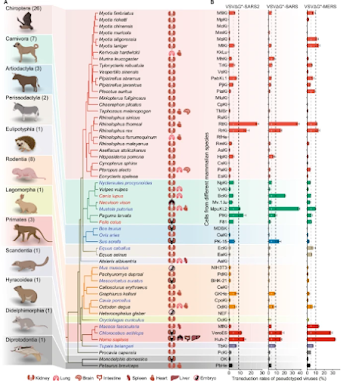
#17,480
Last night Stephanie Soucheray of CIDRAP News reported on a Study: Cats can transmit COVID-19 to each other, conducted by Wageningen University and Research, in the Netherlands. In a press release, tudy coauthor Wim van der Poel DVM, Ph.D., Professor of Emerging and Zoonotic Viruses, stated:
“SARS-CoV-2 transmission between cats is efficient and can be sustained. Infections of cats via exposure to a SARS-CoV-2-contaminated environment cannot be discounted if cats are exposed shortly after contamination."
Aside from concerns over the health and safety of our companion animals, the ability of the SARS-CoV-2 virus to infect and spread within non-human hosts is a serious concern. It not only provides the virus additional reservoir hosts, it may also provide the virus with new and unpredictable evolutionary paths to follow.
Famously, in November of 2020 SARS-CoV-2 jumped from humans to mink in Denmark, spread like wildfire, mutating into new mink-variants (see Denmark Orders Culling Of All Mink Following Discovery Of Mutated Coronavirus), several of which spilled back into the community.This emergency was short-lived as the Alpha variant emerged in Europe in late 2020 and quickly supplanted these mink variants.
We saw a more recent example of this kind of parallel evolution a couple of months ago in Eurosurveillance: Cryptic SARS-CoV-2 Lineage Identified on Two Mink Farms In Poland, when we looked at the detection of two closely related COVID variants that turned up - 3 months apart - at two mink farms in Poland.
Cats and dogs - because they often live in close proximity to humans - are not only at high risk of exposure (see EID Journal: SARS-CoV-2 Seroprevalence Studies in Pets, Spain) they may also serve as a conduit for the virus to infect other peridomestic animals.
Already we've seen dozens of examples of SARS-CoV-2 spilling over into wildlife, including:
Viruses: Detection of SARS-CoV-2 in Terrestrial Animals in Southern Nigeria
PNAS: White-Tailed Deer as a Wildlife Reservoir for Nearly Extinct SARS-CoV-2 Variants
A SARS-CoV-2: Companion Animal Transmission and Variants Classification
by Rachana Pandit 1 andQiana L. Matthews 1,2,*Pathogens 2023, 12(6), 775; https://doi.org/10.3390/pathogens12060775
Abstract
The continuous emergence of novel viruses and their diseases are a threat to global public health as there have been three outbreaks of coronaviruses that are highly pathogenic to humans in the span of the last two decades, severe acute respiratory syndrome (SARS)-CoV in 2002, Middle East respiratory syndrome (MERS)-CoV in 2012, and novel SARS-CoV-2 which emerged in 2019. The unprecedented spread of SARS-CoV-2 worldwide has given rise to multiple SARS-CoV-2 variants that have either altered transmissibility, infectivity, or immune escaping ability, causing diseases in a broad range of animals including human and non-human hosts such as companion, farm, zoo, or wild animals.
In this review, we have discussed the recent SARS-CoV-2 outbreak, potential animal reservoirs, and natural infections in companion and farm animals, with a particular focus on SARS-CoV-2 variants. The expeditious development of COVID-19 vaccines and the advancements in antiviral therapeutics have contained the COVID-19 pandemic to some extent; however, extensive research and surveillance concerning viral epidemiology, animal transmission, variants, or seroprevalence in diverse hosts are essential for the future eradication of COVID-19.
(SNIP)
4. Potential Animal Reservoirs of SARS-CoV-2
As the world is amid a COVID-19 pandemic, the exact source of the SARS-CoV-2 origin and its intermediate host for crossing the species barrier to infect humans is still unknown. SARS-CoV-2 is most likely zoonotic in origin, and infections have been documented in human and non-human hosts such as companion, farm, zoo, or wild animals, indicative of its expanded host range compared to SARS-CoV and MERS-CoV.
As of the 31 of December 2022, 36 countries have reported a total of 699 outbreaks in 26 different animals species, such as cats, dogs, minks, pet ferrets, otters, tigers, white-tailed deer, lynx, hamsters, monkeys, snow leopards, gorillas, and others, indicative of gradual host range expansion [31]. Correspondingly, it is imperative to review the potential animal reservoirs and naturally susceptible infections to companion animals and farm animals that are in prolonged contact with humans as probable reservoirs or hosts that can further lead to the emergence of new variants with spillback capacity to humans (Figure 3).
(SNIP)7. ConclusionsThe emergence of SARS-CoV-2 variants and their rapid spread has posed a great need for research into viruses, their diseases, and infections in animals and humans. SARS-CoV-2 is the third highly pathogenic human CoV to emerge in the 21st century, which has crossed species barriers to infect humans and animals such as companion, farm, zoo, or wild animals.
Correspondingly, new variants of SARS-CoV-2 are continuously evolving, and monitoring each variant is essential to control the rapid spread, even more so when SARS-CoV-2 infection can affect multiple human and animal hosts. The advent of effective therapeutics and vaccines provides hope for controlling the ongoing COVID-19 pandemic; however, the susceptibility of the virus to a broad range of hosts and the continuous evolution of SARS-CoV-2 variants is very daunting.
Hence, to fully eradicate COVID-19 in the future, an extensive understanding and surveillance of SARS-CoV-2 epidemiology, reservoir species, animal host susceptibility, variants, and vaccine efficacy is needed, along with effective vaccination and booster immunization to humans and animals.
Today, variants of SARS-CoV-2 now circulate - alongside MERS-CoV, and other coronaviruses - in dozens of species (see Nature: Comparative Susceptibility of SARS-CoV-2, SARS-CoV, and MERS-CoV Across Mammals).
Not only is there the very real potential for a spillback of a mutated COVID virus from another species into humans, some scientists worry that a recombinant SARS/MERS virus might someday emerge (see Nature: CoV Recombination Potential & The Need For the Development of Pan-CoV Vaccines).
For the past 500 years (probably longer) influenza viruses have been our primary pandemic concern.


